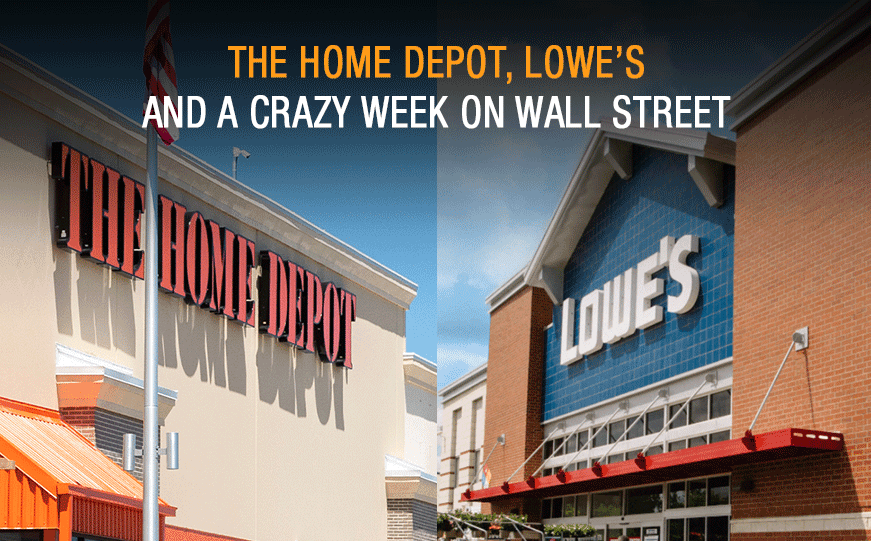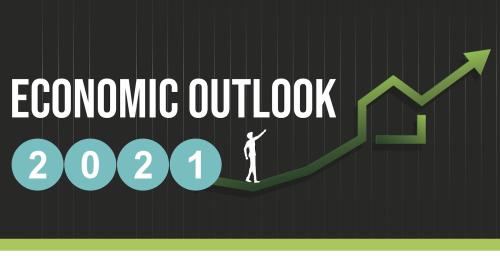When it comes to the economy, this past week was particularly eventful. On Thursday, the Dow Jones tumbled 1,160 points, experiencing its worst trading day since June 2020.
On Tuesday, big box retail quarterly earnings reports were announced by The Home Depot, Lowe’s, Walmart and Target. As the four “biggest” box retailers — their quarterly performance act as a major barometer of the health of the U.S. retail environment.
And, when retail sales metrics are combined with interest rates, housing starts, rates of inflation, and other macro-economic indicators… we can get a pretty good analysis of where the U.S. economy is.
Steady as It Grows
Last week’s shining star of big box earnings reports was The Home Depot.
The Atlanta-based company posted earnings per share of $4.09 for the first quarter… beating analyst estimates by $0.39. Overall, revenue surpassed previous estimates by more than $2 billion — to reach $38.91 billion for the quarter — the highest number in the company’s history.
What’s particularly rewarding is to consider that analysts had predicted an actual decline in sales. Rather, the company defied expectations… increasing comparable sales for the quarter by 2.2 percent. The Home Depot continues to maintain strong margins, despite pressure from inflation and supply chain snarls.
“Our customers are resilient. We are not seeing the sensitivity to that level of inflation that we would have initially expected,” Home Depot CEO Ted Decker said.
Shifting Tides
Closely correlated on the building product retail spectrum sits Lowe’s.99 Lowe’s posted an earnings per share of $3.51 — better than the $3.22 analysts expected — and announced revenue of $23.66 billion. That’s only slightly less than the $23.76 billion expected. While comparable sales decreased by 3.8 percent for the first quarter… pro customer sales increased by 20 percent. This is significant for the B2B channel of influence where our clients anticipate continuing sales success.
Lowe’s blamed unseasonably cold weather in April for the sales decline, which hurt demand for supplies for do-it-yourself projects. “Because 75 percent of our customer base is DIY, our Q1 sales were disproportionately impacted by the cooler spring temperatures,” CEO Marvin Ellison said.
Interestingly, the retailer recently opened its first fulfillment center dedicated solely to serving its professional consumer base. According to the company, any customer is able to order products such as lumber, roofing, shingles, insulation, windows and doors… for next day delivery direct to the jobsite.
Both The Home Depot and Lowe’s benefitted from the significant rise in home improvement spending last year fueled by stay-at-home requirements and the federal stimulus.
Yet, in building momentum, The Home Depot is doing something that Lowe’s may be missing.
Forging Ahead
Supply chain disruptions, increasing inflation and fuel costs, and labor shortages aren’t news. All businesses are dealing with these conditions today. What sets winners apart — is what they do — when faced with a given series of challenges.
The Home Depot appears to be rising to recent challenges by doubling down on its core business. While total transactions fell 8.2 percent from last year, the average ticket price grew by 11.4 percent.
True, some of that price increase can be attributed to inflation, but it doesn’t explain away the increase entirely. It’s apparent that The Home Depot customers are buying higher ticket items.
Executives reported this past Tuesday that sales from their pro customers outpaced those from DIY customers, and that the company is continuing to invest in this important segment.
It’s these same pro customers who continue to take advantage of the real opportunities of the current economy — housing and construction.
Continued Momentum
Houses are selling at a record-breaking pace this spring. The typical home on the market sold in just 15 days during the four-week period ending on May 8, according to data released last week by real estate brokerage Redfin.
These accelerated home sales are happening… even as the cost of ownership is rising. Home prices and mortgage rates have both been increasing rapidly, with rates for a 30-year mortgage averaging 5.30 percent as of last week. Yes, the median home price is up 17 percent from 2021. And the typical monthly mortgage payment has risen by 44 percent over the past year.
These trends haven’t cooled the market. Instead, they seem to be forcing buyers’ hands, as they rush to buy homes now before they become even more expensive.
While new housing (including build-for-rent and townhomes) remains on an important trajectory, home construction fell slightly in April for the second month in a row… suggesting that rising mortgage rates, record home prices, and the high cost of building materials may be starting to smell the effect of what may become stagflation.
Housing starts in April dipped 0.2 percent to an annual pace of 1.72 million. However, that slight dip was based on February’s 16-year high in housing starts.
Total construction starts rose 3 percent in April to a seasonally adjusted annual rate of $945.8 billion, according to Dodge Construction Network. Nonresidential building starts rose 6 percent.
Year-to-date total construction was 6 percent higher in the first four months of 2022… compared to the same period in 2021. Nonresidential building starts rose 19 percent. And residential starts gained 3 percent. For the 12 months ending April 2022… total construction starts were 12 percent higher year-over-year.
The housing market remains robust… with the inventory of homes available dropping to a four-decade low and prices continuing to increase.
These numbers bode exceptionally well for building product brands. Following the example of The Home Depot, brands that double down on their core business are much more likely to continue to grow and prosper.
Staying the Course
While the world is certainly experiencing a number of disruptions, now is not the time to be distracted by lockdowns in China or even invasions in Ukraine.
Over three decades, K&A has navigated many economic cycles and interest rate environments. We’re not overly swayed when we hear, “it’s different this time.” After all, the U.S. is not in a recession, and — despite the churn of current events — is not likely to cross into one this year. That’s something that building product brands can point their sails toward.
This article first ran as a post on KleberandAssociates.com












